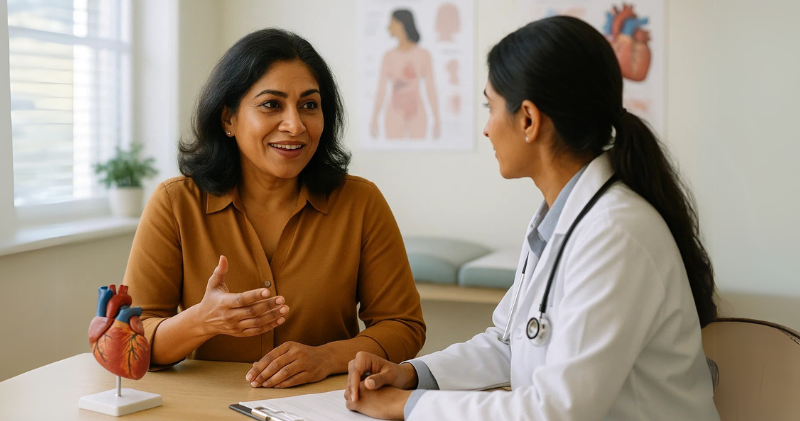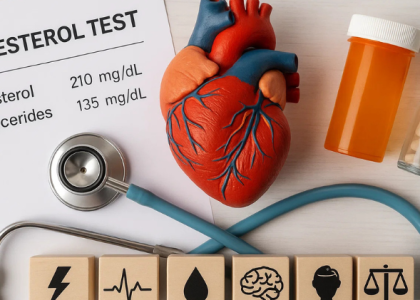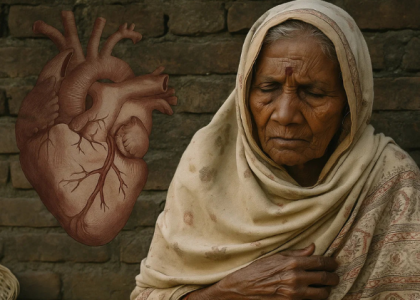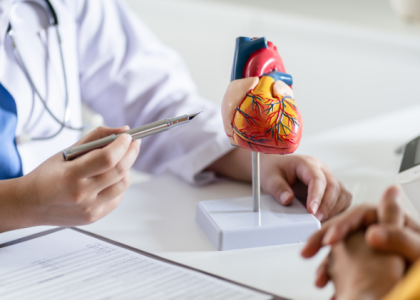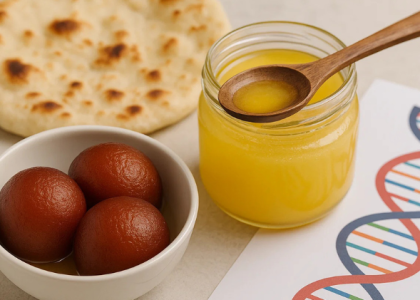Kavitha was cooking dinner when the nausea hit. At 52, she’d been having these “stomach problems” for weeks—burning in her chest, fatigue that made her want to lie down, and an odd ache between her shoulder blades.
“Must be acidity from all the spices,” she told her daughter Priya. “I’ll take some antacid and rest.”
But the symptoms got worse. When Kavitha started sweating and felt dizzy, Priya insisted they go to the hospital. The emergency room doctor’s words shocked them both: “You’re having a heart attack. We need to act now.”
Kavitha couldn’t believe it. “But I don’t have chest pain! Heart attacks hurt, right? This just feels like indigestion.”
The cardiologist explained something that could save every woman’s life: “Women’s heart attacks often don’t cause the crushing chest pain you see in movies. Your nausea, fatigue, back pain, and burning sensation were all classic heart attack symptoms—for women.”
If Kavitha had waited longer, she might not have survived. Her story shows why South Asian women are dying from heart attacks that could be prevented—if only we knew the warning signs.
How Women’s Symptoms Differ
Hollywood has taught us that heart attacks look like a man clutching his chest and falling to the ground. But women’s heart attacks are often completely different.
Classic “male” heart attack symptoms:
- Crushing chest pain
- Pain radiating down the left arm
- Sudden, severe symptoms
- Obvious distress
Common women’s heart attack symptoms:
- Nausea and vomiting: Often mistaken for food poisoning or stomach flu
- Extreme fatigue: Feeling exhausted for days or weeks before the attack
- Back, neck, or jaw pain: Dismissed as muscle strain or stress
- Shortness of breath: Without chest pain
- Burning sensation in chest: Feels like heartburn or acidity
- Dizziness or lightheadedness: Blamed on low blood pressure or dehydration
- Sweating: Cold, clammy sweat without obvious cause
Why women’s symptoms are different: Research shows women’s heart attacks often involve smaller arteries and different types of blockages. Women are more likely to have:
- Spasms in smaller heart arteries
- Tears in artery walls (spontaneous coronary artery dissection)
- Blockages that develop gradually rather than suddenly
The dangerous result: Women’s heart attacks are often misdiagnosed or dismissed. Even emergency room doctors sometimes miss heart attacks in women because the symptoms seem “too mild” or “not typical.”
South Asian women face extra challenges:
- We’re taught to endure pain silently (“Sehan karna chahiye”)
- Family responsibilities come first, personal health comes last
- Cultural reluctance to seek medical care for “minor” symptoms
- Language barriers when describing symptoms
- Doctors may have unconscious bias about heart disease in South Asian women
Why Many South Asian Women Ignore Early Signs
South Asian culture often teaches women to put everyone else’s needs first. This cultural conditioning can be deadly when it comes to heart attacks.
“It’s just stress” mentality: Many South Asian women attribute heart symptoms to family stress, work pressure, or emotional problems. Chest burning becomes “acidity from worry.” Fatigue becomes “tiredness from taking care of everyone.”
Cultural barriers to seeking help:
- Self-sacrifice is valued: “Good” women don’t complain about their health
- Fear of being a burden: “I don’t want to trouble anyone”
- Minimizing symptoms: “It’s probably nothing serious”
- Family first mindset: “I can’t go to the hospital—who will cook dinner?”
Economic concerns:
- Worry about medical bills
- Fear of missing work
- Concern about family finances
- Not wanting to “waste money” on what might be nothing
Language and communication barriers:
- Difficulty describing symptoms in English
- Embarrassment about seeking help
- Not knowing how to explain cultural context to doctors
- Assuming doctors won’t understand
Generational patterns: Many South Asian women learned from mothers and grandmothers who also ignored their health. This creates cycles where serious symptoms are normalized and dismissed.
The “good patient” syndrome: South Asian women often try to be “good patients” by not complaining, not asking questions, and not “bothering” doctors. This can lead to under-reporting symptoms and delayed diagnosis.
Real consequences: These cultural factors contribute to South Asian women having:
- Later diagnosis of heart disease
- More severe heart attacks when they finally seek help
- Worse outcomes after heart attacks
- Higher death rates from heart disease
Case Examples
These real-world scenarios show how heart attacks present differently in South Asian women:
Case 1: Meera, Age 48 Symptoms: Three weeks of unusual fatigue, occasional nausea after meals, and jaw pain she attributed to teeth grinding at night. What she thought: “I’m just tired from work stress and need to see a dentist.” Reality: Silent heart attack was damaging her heart muscle. By the time she collapsed at work, significant damage had occurred. Lesson: Unexplained fatigue lasting more than a few days needs medical evaluation.
Case 2: Deepa, Age 55 Symptoms: Burning sensation in her chest after climbing stairs, shortness of breath while cooking, and sweating episodes she blamed on menopause. What she thought: “It’s just heartburn and hot flashes. All women my age have these problems.” Reality: Her main heart artery was 90% blocked. Emergency surgery saved her life. Lesson: New symptoms during physical activity are warning signs, not normal aging.
Case 3: Asha, Age 44 Symptoms: Severe back pain between shoulder blades, nausea, and dizziness. No chest pain at all. What she thought: “I must have lifted something heavy wrong. Maybe I have a stomach bug too.” Reality: She was having a heart attack. The back pain was referred pain from her heart. Lesson: Heart attack pain can be felt anywhere from the jaw to the abdomen.
Case 4: Lakshmi, Age 61 Symptoms: Felt like she had the flu—nausea, sweating, weakness, and vague chest discomfort. What she thought: “Everyone in the family has been sick. I caught something.” Reality: Heart attack symptoms mimicking flu. She delayed seeking help for two days. Lesson: “Flu-like” symptoms in women over 50 can be heart attacks.
Common patterns in these cases:
- Symptoms developed gradually over days or weeks
- Women attributed symptoms to other common causes
- No classic crushing chest pain
- Delay in seeking medical help
- Symptoms worsened with physical activity
When to Go to the Hospital
Knowing when to seek emergency care can save your life. Don’t wait for “classic” symptoms.
Go to the emergency room immediately if you have:
- Chest pain or pressure (even if mild)
- Nausea with chest discomfort
- Unexplained sweating (especially cold, clammy sweat)
- Shortness of breath without obvious cause
- Pain in jaw, neck, back, or arms that’s new or severe
- Extreme fatigue that came on suddenly
- Dizziness with other symptoms
The “rule of 2s”: If you have 2 or more unusual symptoms that started around the same time, seek immediate medical attention.
Don’t delay if:
- Symptoms are getting worse
- You feel a sense of impending doom
- Symptoms interfere with normal activities
- You have risk factors (diabetes, high blood pressure, family history)
What NOT to do:
- Don’t drive yourself to the hospital
- Don’t take antacids and wait to see if symptoms improve
- Don’t assume it’s “just stress” or “just acidity”
- Don’t wait until morning if symptoms start at night
- Don’t worry about “bothering” anyone
Call 101 (or local emergency number) when:
- Symptoms are severe or getting worse rapidly
- You feel faint or might collapse
- You’re alone and feel unsafe
- You have a history of heart problems
What to say to emergency dispatchers: “I’m a [age]-year-old woman having possible heart attack symptoms including [list your symptoms]. I need an ambulance immediately.”
At the hospital:
- Tell them you’re concerned about a heart attack
- List all your symptoms, even if they seem unrelated
- Mention any family history of heart disease
- Don’t downplay your symptoms or say “it’s probably nothing”
Did You Know? Nausea, fatigue, or back pain can be heart attack symptoms in women—and these “quiet” symptoms are especially common in South Asian women. Studies show that 43% of women having heart attacks don’t experience chest pain at all. Instead, they have symptoms that mimic indigestion, flu, or muscle strain, leading to dangerous delays in treatment.
How Families Can Help
Heart attacks affect entire families, not just the patient. Here’s how family members can save lives:
Educate everyone about women’s symptoms:
- Share this information with all adult family members
- Discuss the differences between men’s and women’s heart attack symptoms
- Make sure everyone knows that chest pain isn’t always present
- Teach children to recognize when adults need emergency help
Create a family emergency plan:
- Keep emergency numbers easily accessible
- Identify the nearest hospital with cardiac capabilities
- Know who to call if the primary caregiver has symptoms
- Have transportation plans ready
Watch for warning signs in the women you love:
- Notice if mom, wife, sister, or aunt seems unusually tired
- Pay attention to complaints about “indigestion” or “heartburn”
- Be alert to new symptoms during physical activity
- Don’t dismiss their concerns as “just stress”
Overcome cultural barriers:
- Give women permission to seek medical care
- Offer to handle household duties so they can rest or see a doctor
- Don’t use guilt or family obligations to discourage medical visits
- Model good health-seeking behavior for younger generations
Support during medical visits:
- Offer to accompany women to doctor appointments
- Help them prepare lists of symptoms and questions
- Advocate for them if symptoms aren’t taken seriously
- Translate if needed and help communicate with medical staff
After a heart attack:
- Support medication compliance
- Help with lifestyle changes
- Encourage cardiac rehabilitation
- Watch for signs of depression (common after heart attacks)
- Create supportive environment for recovery
Special considerations for elderly women:
- Check on them regularly
- Help them understand their medications
- Ensure they have transportation to medical appointments
- Watch for subtle changes in energy or appetite
Breaking generational patterns:
- Teach younger women that their health matters
- Model self-care and appropriate help-seeking
- Challenge cultural messages that prioritize self-sacrifice over health
- Celebrate women who take care of their health
Action Steps
Protect the women in your life starting today:
Learn the “quiet” signs of heart attack: Memorize these symptoms that don’t involve chest pain: unexplained nausea, extreme fatigue, back/neck/jaw pain, shortness of breath, sweating, and dizziness. Share this list with every woman in your family. Put it on your refrigerator or save it in your phone. These symptoms are especially common in South Asian women.
Don’t delay going to the ER: If you or a woman you love has concerning symptoms, go to the emergency room within 30 minutes. Don’t wait to see if symptoms improve. Don’t worry about false alarms—emergency rooms would rather see 10 false alarms than miss one real heart attack. Time is heart muscle.
Encourage checkups for your mom/aunt/sister: Schedule or encourage annual heart health screenings for every woman in your family over 40 (or 35 with risk factors). This includes blood pressure, cholesterol, diabetes screening, and EKG. Early detection and prevention save lives. Don’t let cultural reluctance prevent life-saving medical care.
Create a family heart health discussion: Have a family meeting this month to discuss heart attack symptoms, family history, and emergency plans. Make sure everyone knows the women’s heart attack symptoms and agrees that seeking emergency care is always the right choice when in doubt.
Frequently Asked Questions
Q: My mother always says her chest burning is just acidity. How can I tell if it’s really her heart? A: Heart-related chest burning often gets worse with physical activity and may be accompanied by sweating, nausea, or shortness of breath. Acidity usually improves with antacids and food. If symptoms are new, getting worse, or associated with other symptoms, insist on medical evaluation. Trust your instincts.
Q: Are South Asian women really at higher risk for heart attacks than other women? A: Yes. South Asian women develop heart disease 10 years earlier than women from other ethnic groups. We’re more likely to have diabetes, high blood pressure, and other risk factors. We’re also more likely to delay seeking treatment, leading to worse outcomes. This makes awareness and early action even more critical.
Q: What if we go to the ER and it’s not a heart attack? Will we look foolish? A: Never worry about false alarms with heart attack symptoms. Emergency rooms see many patients with chest pain that isn’t heart-related, and they never consider it a waste of time. It’s far better to have 10 false alarms than to miss one real heart attack. Your life is worth more than temporary embarrassment.
References
- McSweeney, J.C., et al. (2016). Women’s early warning symptoms of acute myocardial infarction. Circulation, 108(21), 2619–2623.
- Mehta, L.S., et al. (2016). Acute myocardial infarction in women: a scientific statement from the American Heart Association. Circulation, 133(9), 916–947.
- Joshi, P., et al. (2007). The prevalence and correlates of coronary artery disease in South Asians. JACC: Cardiovascular Imaging, 2(2), 76–85.
- Lichtman, J.H., et al. (2014). Symptom recognition and healthcare experiences of young women with acute myocardial infarction. Circulation: Cardiovascular Quality and Outcomes, 8(2), S31–S38.
- Anand, S.S., et al. (2000). Risk factors, atherosclerosis, and cardiovascular disease among Aboriginal people in Canada. The Lancet, 356(9228), 279–284.
- D’Onofrio, G., et al. (2017). Sex differences in reperfusion in young patients with ST-segment-elevation myocardial infarction. JAMA Cardiology, 2(4), 360–368.
- Khan, N.A., et al. (2013). Sex differences in acute coronary syndrome symptom presentation in young patients. JAMA Internal Medicine, 173(20), 1863–1871.
If this helped you, please share it with someone you love.
